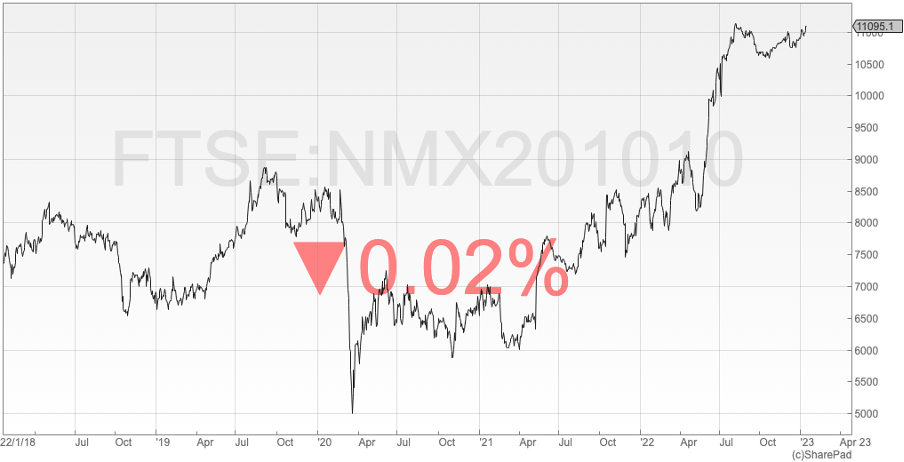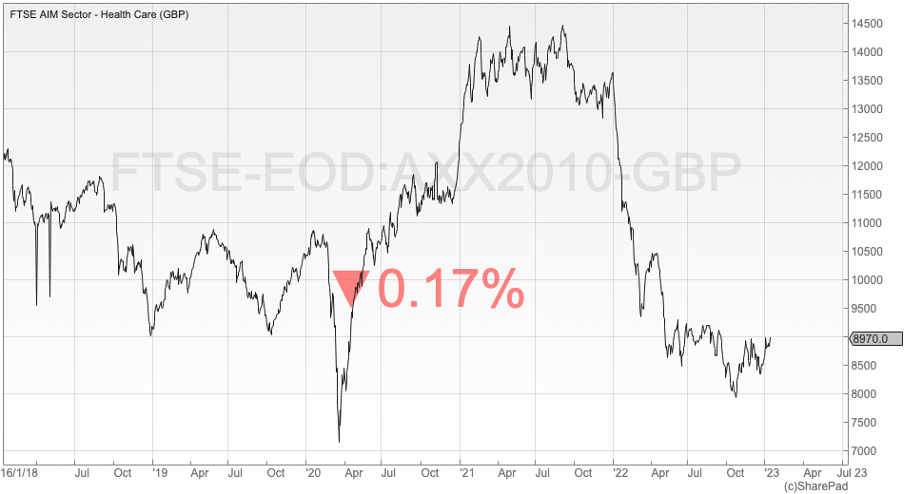10 great healthcare shares for defensive investors
18th January 2023 14:17
by Ben Hobson from interactive investor
With inflation stuck in double figures and the economic outlook uncertain, these healthcare shares could be winners in 2023, according to stock screen expert Ben Hobson.

Healthcare is traditionally seen as one of the market’s most defensive industries - and that’s certainly something we’ve seen in the UK market recently. Over the past three years, the sector has performed relatively well in the face of both the Covid pandemic and last year’s market wide sell-off.
Care provision, pharma and biotech, devices and services are home to some of the biggest and best-known companies in the market (and in some cases the world). But these sectors also account for a vast range of smaller and much more speculative players.
- Invest with ii: Top UK Shares | Share Tips & Ideas | Cashback Offers
For the investor looking for defensive qualities in a sector with attractive structural tailwinds, it’s important to tread carefully. Not all healthcare companies offer the traits you might be looking for. So what kind of screening approaches might help you pin them down?
A defensive industry with a speculative edge
When it comes to stock market sectors, healthcare comes with some eye-catching dynamics. There are around 125 companies in the sector across the UK Main Market and the Alternative Investment Market (AIM). Not all of them are human health firms - the sector also includes a handful of animal health and veterinary shares.
With a market cap of around £181 billion, AstraZeneca (LSE:AZN) is not only far and away the largest healthcare company in the market, it’s also the largest company full-stop.
Only 11 other shares in the sector have a market cap of more than £1 billion, and when you add them together, their combined value falls just short of AstraZeneca, at £173 billion.
At the other end of the size spectrum, 78 of those 125 companies have a market cap below £100 million, and 25 of them are under £20 million.
Overall, only around 40 shares in the sector have posted positive earnings in each of the last three financial years. Only 35 are forecast to deliver positive earnings in the year ahead.
So with only around a third of healthcare companies delivering anything like positive earnings in recent years, it gives you an idea of just how speculative much of this sector really is.
Small scientific companies have always been attracted to the Alternative Investment Market. Light-touch regulation and relatively easy access to funding make AIM an attractive location for these firms. For investors that manage to pick the winners, the returns can very occasionally be impressive. But those lottery-like shares are rare - as the charts below show.

SharePad: FTSE 350 Sector - Health Care Providers
Over the past five years, the two main FTSE 350 Healthcare indices - Healthcare Providers (above) and Pharmaceuticals, Biotechnology & Cannabis Producers (below) - have both done well. These Main Market indices are where the larger, more developed companies are found.

SharePad: FTSE 350 Sector - Pharmaceuticals, Biotechnology & Cannabis Producers
But the FTSE AIM Health Care Index (below) tells a different story. The speculative nature of small and micro-cap healthcare shares, and the general malaise towards AIM last year, has left the index in a rather poor state on a five-year basis. The recovery post-Covid was impressive, but the decline in 2022 was swift and brutal.

SharePad: FTSE AIM Sector - Health Care
Healthcare as a defensive play for a portfolio
Last week I mentioned research that shows how healthcare tends to be a sector that performs better than most in bearish conditions. This closer inspection of recent trends in the UK market shows that larger-cap healthcare shares have been far more resilient than small-caps on average in recent years.
With inflation still stuck in double figures, the economic outlook remains uncertain, which means that healthcare could remain an area of interest for stock-pickers for some time yet.
This screen looks for healthcare companies across the market where earnings are positive and five-year average operating margins are above 8%. These rules are designed to strip out unprofitable and highly speculative firms.
In addition, the table shows how earnings are forecast to change in the year ahead for these companies, what their forecast price/earnings ratios are and their relative share price strength over the past 12 months and past three months.
Name | Relative price strength 1y | Relative price strength 3m | Operating margin 5y av. | Forecast P/E ratio | Forecast EPS change % | Subsector |
66.2 | 13.7 | 26.6 | 22.1 | 20.9 | Pharmaceuticals | |
38 | 1.7 | 21 | 24.6 | -4.9 | Medical Supplies | |
32.1 | 4.1 | 15.1 | 21.4 | 25.9 | Pharmaceuticals | |
27.2 | 8.2 | 77.4 | 27.2 | 4.5 | Biotechnology | |
1.8 | -3.6 | 8.4 | 30.4 | 3.2 | Biotechnology | |
-6.4 | 14.9 | 22.1 | 18.1 | 14.5 | Medical Equipment | |
-5.3 | -1.9 | 9.1 | 75.4 | - | Health Care Facilities | |
-7.1 | 5.1 | 17.2 | 38.5 | 16.1 | Health Care Services | |
-9.5 | -2.2 | 17.7 | 17.9 | -3.1 | Medical Equipment | |
-13.2 | -14.6 | 19.8 | 17.5 | 6.9 | Medical Equipment |
What are stock pickers facing in this more defensive area of the healthcare sector?
For a start, forecast PE ratios are generally in the high-teens and over 20x (with the exception of Ergomed (LSE:ERGO) at just 8.4x). As a rule of thumb, a PE of 20x or more can point to richly rated stocks, so if you were hunting here you’d need to consider that valuations might be pricey in places.
In terms of price strength, the top shares in this list have delivered a strong performance over the past year, but it’s also worth noting that the past three months have also seen some solid performances.
In terms of profitability, there is evidence of strong appeal. All these shares have solid double-digit average operating margins, which is a hallmark of decent pricing power. It’s something that makes established healthcare companies appealing.
As an example, small-cap biotech firm Bioventix (LSE:BVXP) has blistering average margins of 77%, but large-caps like ConvaTec Group (LSE:CTEC), AstraZeneca and Smith & Nephew (LSE:SN.) all have strong profitability indicators.
Not all of them are expected to see earnings grow in the year ahead, but companies like Indivior (LSE:INDV), Astra, Medica Group (LSE:MGP) and Tristel (LSE:TSTL) are all expected to see earnings rise meaningfully.
Avoiding pain in UK healthcare shares
Overall, the lesson here is that a number of UK healthcare shares have performed exactly as you would expect for a defensive sector that tends to do better than others in a bear market. The past three years have seen some strong returns for investors - but it’s worth treading carefully in the search for ideas.
With so many healthcare shares either unprofitable, unproven or just plainly unreliable, the real defensive element in this part of the market is among the mid- and large-caps. That’s not to say that in the search for lottery-like returns, you should avoid those speculative plays. But if you’re trying to avoid pain at an uncertain time for the economy, a prescription for solid profitability is probably what you need.
Ben Hobson is a freelance contributor and not a direct employee of interactive investor.
These articles are provided for information purposes only. Occasionally, an opinion about whether to buy or sell a specific investment may be provided by third parties. The content is not intended to be a personal recommendation to buy or sell any financial instrument or product, or to adopt any investment strategy as it is not provided based on an assessment of your investing knowledge and experience, your financial situation or your investment objectives. The value of your investments, and the income derived from them, may go down as well as up. You may not get back all the money that you invest. The investments referred to in this article may not be suitable for all investors, and if in doubt, an investor should seek advice from a qualified investment adviser.
Full performance can be found on the company or index summary page on the interactive investor website. Simply click on the company's or index name highlighted in the article.
Disclosure
We use a combination of fundamental and technical analysis in forming our view as to the valuation and prospects of an investment. Where relevant we have set out those particular matters we think are important in the above article, but further detail can be found here.
Please note that our article on this investment should not be considered to be a regular publication.
Details of all recommendations issued by ii during the previous 12-month period can be found here.
ii adheres to a strict code of conduct. Contributors may hold shares or have other interests in companies included in these portfolios, which could create a conflict of interests. Contributors intending to write about any financial instruments in which they have an interest are required to disclose such interest to ii and in the article itself. ii will at all times consider whether such interest impairs the objectivity of the recommendation.
In addition, individuals involved in the production of investment articles are subject to a personal account dealing restriction, which prevents them from placing a transaction in the specified instrument(s) for a period before and for five working days after such publication. This is to avoid personal interests conflicting with the interests of the recipients of those investment articles.